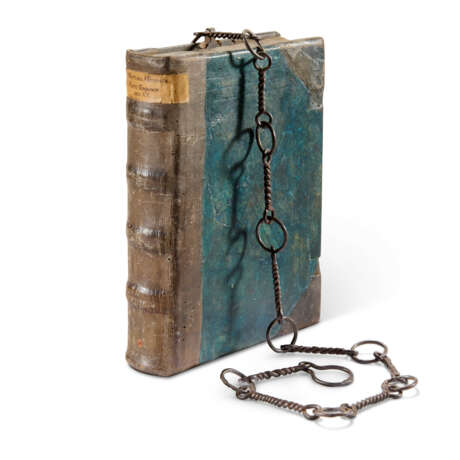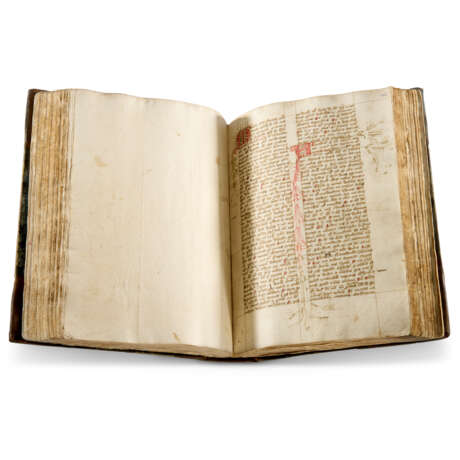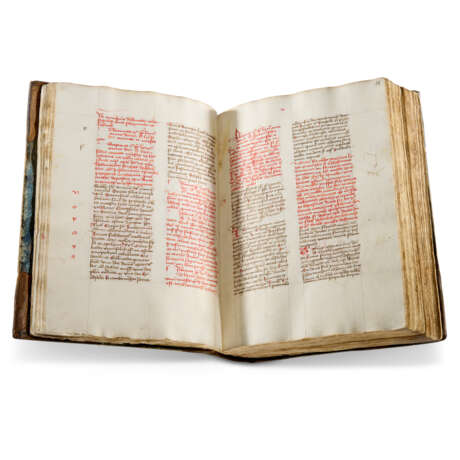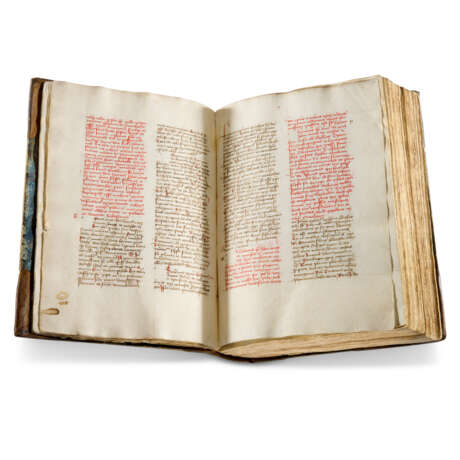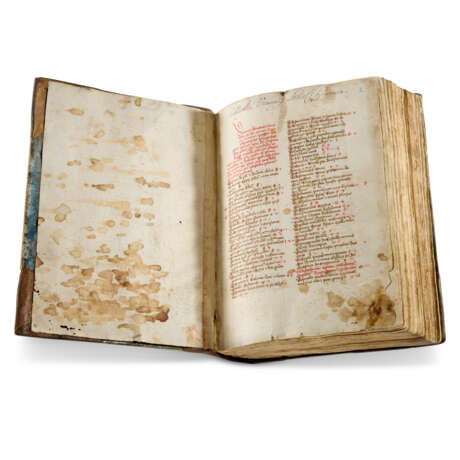ID 1214863
Лот 27 | A chained monastic binding from Zwettl Abbey
Оценочная стоимость
£ 50 000 – 80 000
A sammelband, in Latin with some Middle High German, manuscript on paper [Austria, Zwettl Abbey, c.1380-1430]
A compilation of sermons, chronicles, canon law and patristic texts, several of which contemporary to the lives of their authors, two of which are dated and one signed by the scribe, including one of the two oldest copies of the text of Matthew of Cracow's Dialogue, in a contemporary chained binding from the Cistercian Abbey at Zwettl.
292 x 220mm, i + 254 + ii leaves, complete, collation: 1-1012, 1114, 126, 1312(of 14, xiii-xiv cancelled blanks), 1412, 1510, 166 (of 8, two cancelled blanks), 17-2212, 28-54 lines written in a regular lettre batarde by Jeorius de Cistastorff and other scribes, written space: 190-230 x 150mm, headers and rubrics in red, several large initials throughout decorated in a pattern similar to the chain of the binding, some with penwork flourishes, 3 full-page diagrams of arbores consanguinitatis, endpapers with fragments of a sermon on the Gospels intended for the 3rd Sunday after Epiphany and the Wednesday and Thursday after Ash Wedensday, vellum sewing guards from a medieval manuscript in Hebrew (a few spots to opening leaves, else in excellent condition).
Binding:
Contemporary, probably Zwettl, binding of stained blue leather over thick, unbevelled wooden boards, sewn on 4 wide bands, 17/18th-century brown goatskin spine overlay, 19th-century manuscript title label on spine, early chain of 11 twisted links and staple attached at top of rear board (lacking clasps and catches, minor repairs, a little scuffed, a few wormholes).
Provenance:
(1) Cistercian Abbey at Zwettl, Waldviertel, Austria. The previous lot is in a similar chained binding and has exactly the same provenance. Two of the texts in the compilation are dated: the Matthew of Cracow treatise is dated 1389 and the Alexander de Roes text is dated 1429. The Matthew of Cracow text (more on its importance below) is signed by the scribe Jeorius de Cistastorff, which a previous cataloguer suggested must be today's Zistersdorf in the vicinity of the Cistercian Abbey at Zwettl. It is likely then that Jeorius was a monk at Zwettl and wrote this manuscript for its Library.
(2) Johann Ernst von Jamaigne (1648-1719), Austrian theologian and Protonotary Apostolic in Waidhofen an der Thaya in the diocese of St. Pölten: his armorial ex libris and ink 'N/152' and 'Num. mss. ?35'.
(3) Piarists of Vienna: inscription on f.2 'Bibliothecae Viennensis Scholarum Piarum'. A manuscript of Nicolaus de Gretz in a 15th-century Austrian binding sold at Christie's, 16 October 2020, lot 84, has the same von Jamaigne-Piarist provenance, and a title label on the spine written in the same hand as the present manuscript.
(4) Johann Nepomuk Wilczek (1837-1922), Austrian arctic explorer, main sponsor of the Austro-Hungarian North Pole Expedition of 1872-74 and celebrated patron of the arts. The present manuscript was no 5668 (in blue ink on inside upper board) in his library at Schloss Kreuzenstein, a monumental mansion to the north of Vienna redesigned in the late 19th century by Carl Gangolf Kayser, and now home to a museum that houses Wilczek's extensive art collections.
(5) Gilhofer & Ranschburg, Vienna, their description c.1989.
(6) Heribert Tenschert, cat. 22 (1990), no 19.
(7) The Schøyen Collection, MS 691.
Content:
A sammelband of texts, including: 'Martinus Minorita', Flores temporum, beginning: 'Marie virginis indignus ego sacrista [...]', ff.2-61v; Alexander de Roes (d. before 1300), 'Cronica de Imperi Translacione a Grecis in Germanos', dated 1429, beginning 'Multifarie multisque modis dominus [...]', ff.62-69; Honorius of Autun (1080-1154), excerpt from Imago Mundi, beginning with Book III: 'Non arbitror infructuosum seriem temporum huic operi inserere [...]' ff.74-82; blanks ff.83-85; excerpts from canon law, mentioning the Summa of Bartholomeus Pisanus, completed in 1338, 'De Sacramentis. De Excommunicatione maiori et minori. De casibus reservatis', beginning: 'De sacramentis ecclesie et primo de baptismo pro sacerdotibus [...] ff.86-93; blanks ff.93v-98v; Gregory IX et al., excerpts from Decretals, 'Questiones casuum excerpta libri decretalium', beginning 'Labia sacerdotis custodiunt scientiam [...], ff.99-135v; Tables of consanguinity and affinity ff.136-139; blanks ff.139v-141v; Matthew of Cracow (1345-1410), Dialogus rationis et conscientiae, dated 1389, beginning: 'Multorum tam clericorum quam laycorum [...]' ff.142-150; Henry of Hesse (1325-1397), Epistola pacis, beginning: 'Genius magni Iovis vicarius vasta superiorum culmina regnorum', ff.150v-166; blanks ff.166v-170; Pierre d'Ailly (1350-1420), Lectura Sententiarum, beginning: 'Quenam doctrina hec nova?', f.171-171v; excerpts from Pope Innocent III (1161-1216) beginning: 'Incipit liber de miseria humane condicionis', ff.172-181v; Pseudo-Albertus Magnus, Biblia Mariana, beginning: 'In principio creavit deus omnipotens primo celum scilicet empyreum per quod intelligitur domina mundi virgo maria', ff.182-219v; florilegium, or 'Liber scintillarum' beginning: 'Incipit libellus maxime in primis de evangelicisi domini nostri ihu' ff.220-240; a sermon on the Passion, beginning: 'Hodie carissimi est dies tocius nostre salutis', ff.240v-253v.
The Flores temporum is an anonymous work first written by a Franciscan author c.1290 in Swabia in Southwestern Germany. It is often attributed, as here, to 'Martinus Minorita', but the name is probably simply a confusion with the author of another very popular chronicle of the Popes and Emperors, Martinus von Troppau. Some 140 extant manuscripts of the complete chronicle survive, in various versions, and 30 manuscripts that include extracts.
Alexander de Roes (d. before 1300) was from a patrician family of Cologne where he was a Canon of St Mary’s on the Capital; he entered the circle of Cardinal Jacobus de Columna to whom he dedicated his Memoriale de prerogativa Romani imperii, first printed at Cologne in 1474. Alexander’s pro-imperial text incorporated the complete text of a work by Jordanus Osnaburgensis (c.1220-1284) who was a Canon and German political writer, which claimed that divine dispensation had allotted the Empire to Germans via Charlemagne.
Honorius of Autun was a 12th-century Christian theologian who wrote prolifically and conversationally on many subjects. His most important work was the Imago Mundi, an encyclopedia of cosmology and geography combined with a chronicle of world history, popular throughout the Middle Ages. The excerpt in our manuscript contains a chronology from the Creation of the World ('Prima Aetas') to the time of Conrad III (c.1142).
Matthew of Cracow was a central figure in the intellectual and theological world of the prehussite reform movement. His Dialogus, with its focus on the reception of the Eucharist, was hugely influential in the Middle Ages. Some 330 manuscript witnesses survive, and the date in the colophon of the present manuscript indicates that this is one of the two oldest surviving copies of the text (only one manuscript dates back to 1388). On Matthew of Cracow's Dialogus see M. Lužný, Dialog Matouše z Krakova o častém přijímání svátosti oltářní a jeho místo v myšlenkovém světě předhusitského reformního hnutí, 2020. We would like to thank Michael Lužný for pointing out the importance of this text in the present manuscript.
The Biblia Mariana, also known as Biblia beatissimae Mariae virgini, is another fascinating and rare text. It is a compilation and explication of words in the Bible, probably composed in the later 13th-century, which can be interpreted as tropological or allegorical references to the Virgin Mary. Its author was previously thought to be Albertus Magnus. The text was popular in the Middle Ages and survives today in at least thirty-nine manuscripts, but appears to be entirely uncommon on the market.
Literature
Lackner F., Datierte Handschriften in Niederösterreichischen Archiven und Bibliotheken bis zum Jahre 1600, 1988, no 64.
Exhibited
Conference of European National Librarians, Oslo 1994.
| Место происхождения: | Австрия, Западная Европа, Европа |
|---|---|
| Категория аукционного дома: | Манускрипты Средневековья и Ренессанса, Книги и рукописи |
| Место происхождения: | Австрия, Западная Европа, Европа |
|---|---|
| Категория аукционного дома: | Манускрипты Средневековья и Ренессанса, Книги и рукописи |
| Адрес торгов |
CHRISTIE'S 8 King Street, St. James's SW1Y 6QT London Великобритания | |
|---|---|---|
| Предосмотр |
| |
| Телефон | +44 (0)20 7839 9060 | |
| Комиссия | see on Website | |
| Условия использования | Условия использования |
